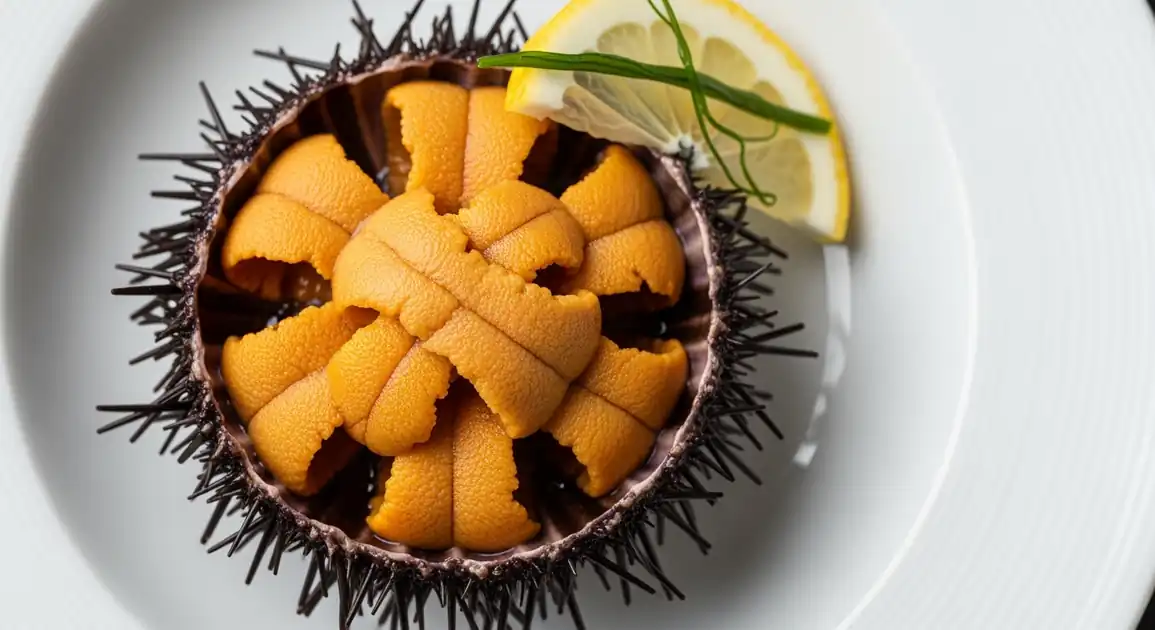Kina (Sea Urchin)
Kina

Description
Throughout New Zealand, kina is an iconic traditional food especially treasured in Māori culture. While it can be found around most of the country's coastline, regional preferences and quality vary based on local marine environments. Northern waters, particularly around the North Island, are known to produce some of the most sought-after kina. The delicacy bridges traditional food ways and contemporary cuisine, increasingly featured in New Zealand's developing culinary identity.
Dietary Information
Serving information
Serving style
Traditionally served in its shell after opening and cleaning, sometimes with a little seawater remaining. Modern presentations include on ice, on toast points, as part of seafood platters, or incorporated into pasta dishes or sauces.
Quick facts
Fish markets typically operate from 7 AM - 5 PM, with the freshest stock available in the morning. Restaurants serving kina follow standard meal service hours (12 PM - 2 PM for lunch, 6 PM - 10 PM for dinner).
Safety Tips
What to Look For
-
Bright orange-yellow roe color
The vibrant color indicates freshness; brown, black, or grayish colors suggest deterioration.
-
Clean, ocean-fresh smell
Fresh kina smells like clean ocean water, never fishy or ammonia-like.
-
Firm, intact roe texture
The roe should hold its shape and not be mushy, watery, or granular.
-
Recently harvested
Ideally eaten within 24-48 hours of harvest; ask vendors when it was collected.
-
Proper refrigeration
Kina should be kept cold, either refrigerated or on ice by vendors.
What to avoid
-
Discolored roe (brown, black, gray)
Indicates spoilage; never consume kina with off-colors.
-
Strong fishy or ammonia smell
Clear signs of deterioration; fresh kina has only a mild ocean scent.
-
Mushy or liquefied texture
The roe should not be breaking down or disintegrating.
-
Cloudy liquid in pre-opened kina
The liquid should be clear; cloudiness suggests bacterial growth.
-
Vendors storing kina at room temperature
Proper refrigeration is essential for safety with raw seafood like kina.
Price information
Price range
Budget tips
- Buying whole, unopened kina is usually more economical (about $5-10 each) than pre-opened ones.
- Fish markets typically offer better value than restaurants, where kina dishes can cost $20-30.
- Coastal communities often have the most reasonable prices, especially if buying directly from harvesters.
- During Māori cultural festivals, kina may be available at special prices or as part of cultural food experiences.
Value indicators
- Bright orange-yellow color indicates good quality.
- Vendor willingness to open the kina for you to inspect.
- Knowledge of harvest location and time.
- Proper storing conditions (refrigerated or on ice).
- Size – larger kina often have more roe, offering better value.
Where to Find This Dish
Fish Markets
Specialized seafood markets are the primary source for fresh kina.
Local fish markets, Seafood specialty stores
Morning, Midday
Coastal Communities
Areas with active fishing industries often have direct access to freshly harvested kina.
Local fish shops, Community markets, Harbors
Morning, Midday
Māori Food Markets
Cultural markets featuring traditional Māori cuisine frequently offer kina.
Marae events, Cultural festivals, Weekend markets in areas with strong Māori communities
Morning, Midday, Afternoon
Vendor Tips
- Ask when and where the kina was harvested - knowledgeable vendors can provide this information.
- Request to see the roe before purchasing if buying pre-opened kina.
- Build relationships with specialty seafood vendors who can alert you when fresh kina arrives.
How to Order
Regional Variations
-
Raw Fresh Kina
(Kina Mata)
The traditional way of eating kina - raw and fresh, sometimes with a little seawater remaining in the shell for added flavor. Often eaten directly from the shell or with bread.
-
Kina on Toast
(Kina Tōhi)
A modern preparation featuring fresh kina roe served on toast, sometimes with butter and herbs. Popular in contemporary New Zealand cafes.
-
Kina Pasta
(Pasta Kina)
Similar to Italian sea urchin pasta, kina roe is mixed with pasta, butter, sometimes cream, and herbs for a luxurious dish found in high-end restaurants.
-
Kina Pâté
(Pāté Kina)
A spread made from kina roe, sometimes mixed with butter or cream cheese and seasonings, served with crackers or bread.
-
Pickled Kina
(Kina Whakaranu)
Less common but traditional preservation method where kina roe is pickled in vinegar solution, sometimes with seaweed, extending its shelf life.
Cultural context
History
Kina has been a treasured food source (kaimoana) for Māori for centuries before European settlement. Traditional harvesting was governed by strict protocols (tikanga) ensuring sustainability. Māori would collect kina during seasonal gatherings, often coinciding with lunar cycles. European settlers initially showed little interest in kina, but in recent decades, it has gained wider appreciation in New Zealand's culinary scene, sometimes called 'New Zealand uni' by those familiar with Japanese cuisine. Today, it represents both cultural heritage and a unique local delicacy that bridges traditional and contemporary New Zealand food culture.
Local significance
Kina holds profound cultural importance for Māori as a traditional delicacy (kaimoana) and represents connection to the ocean and ancestral food gathering practices. The knowledge of harvesting and enjoying kina is passed down through generations.
Eating customs
- Traditionally eaten fresh and raw directly from the shell.
- Often shared communally at gatherings and celebrations.
- Modern appreciation includes both traditional consumption and contemporary culinary adaptations.